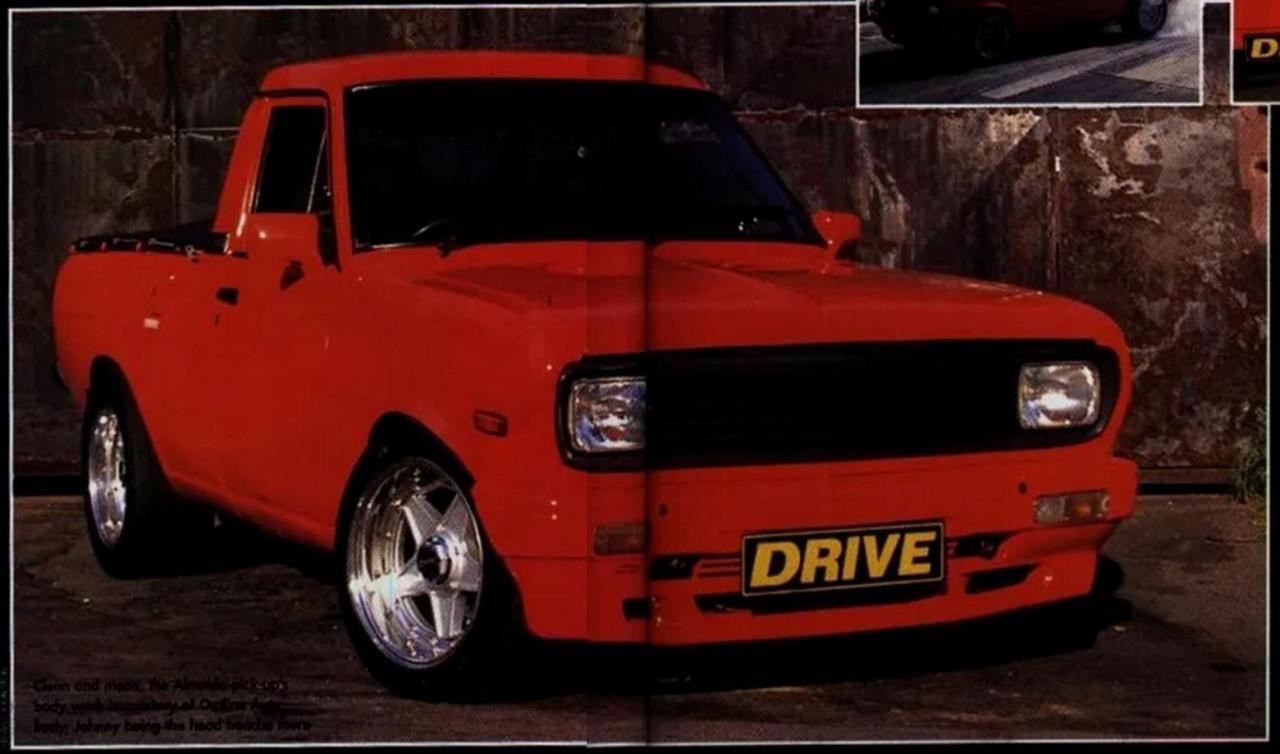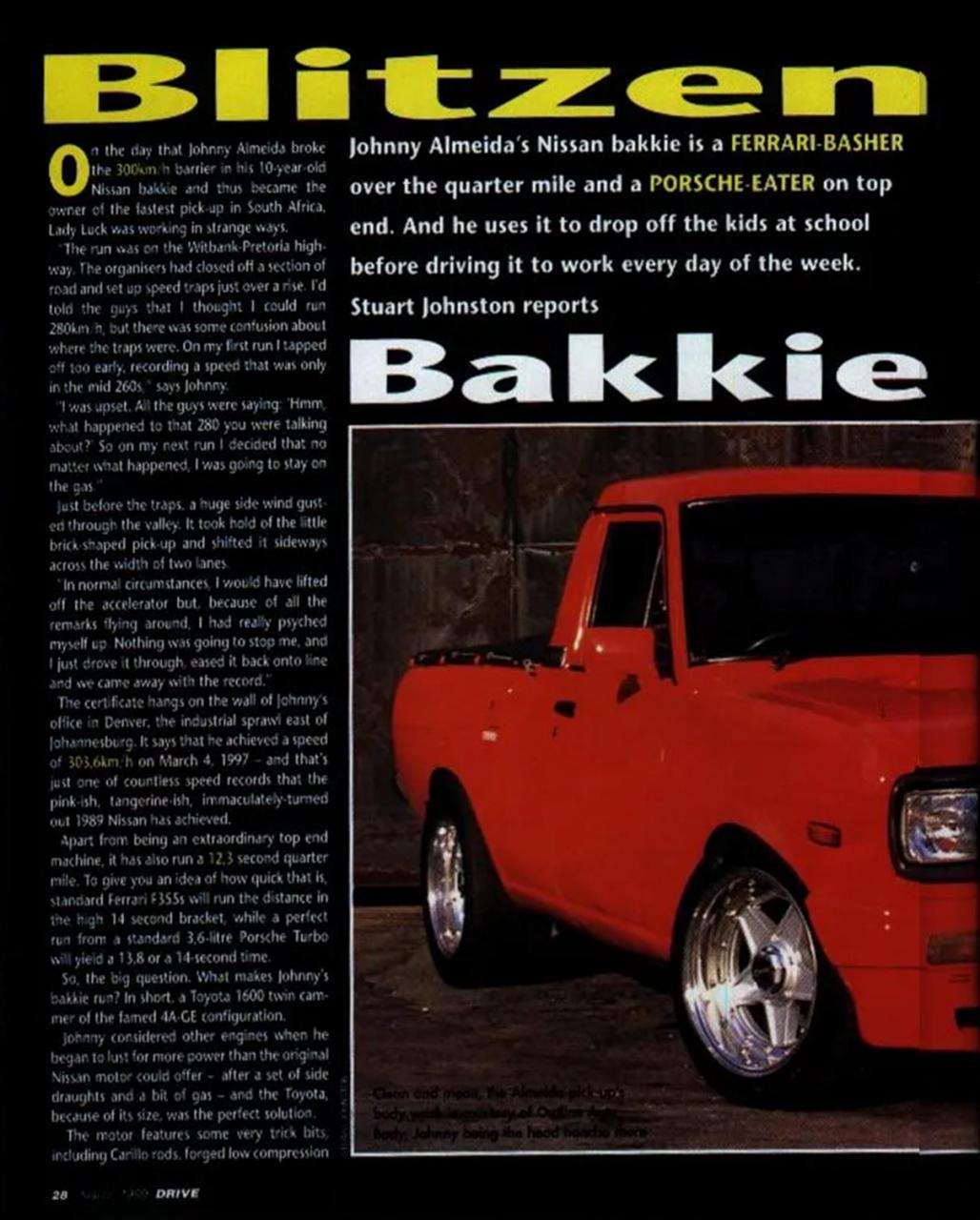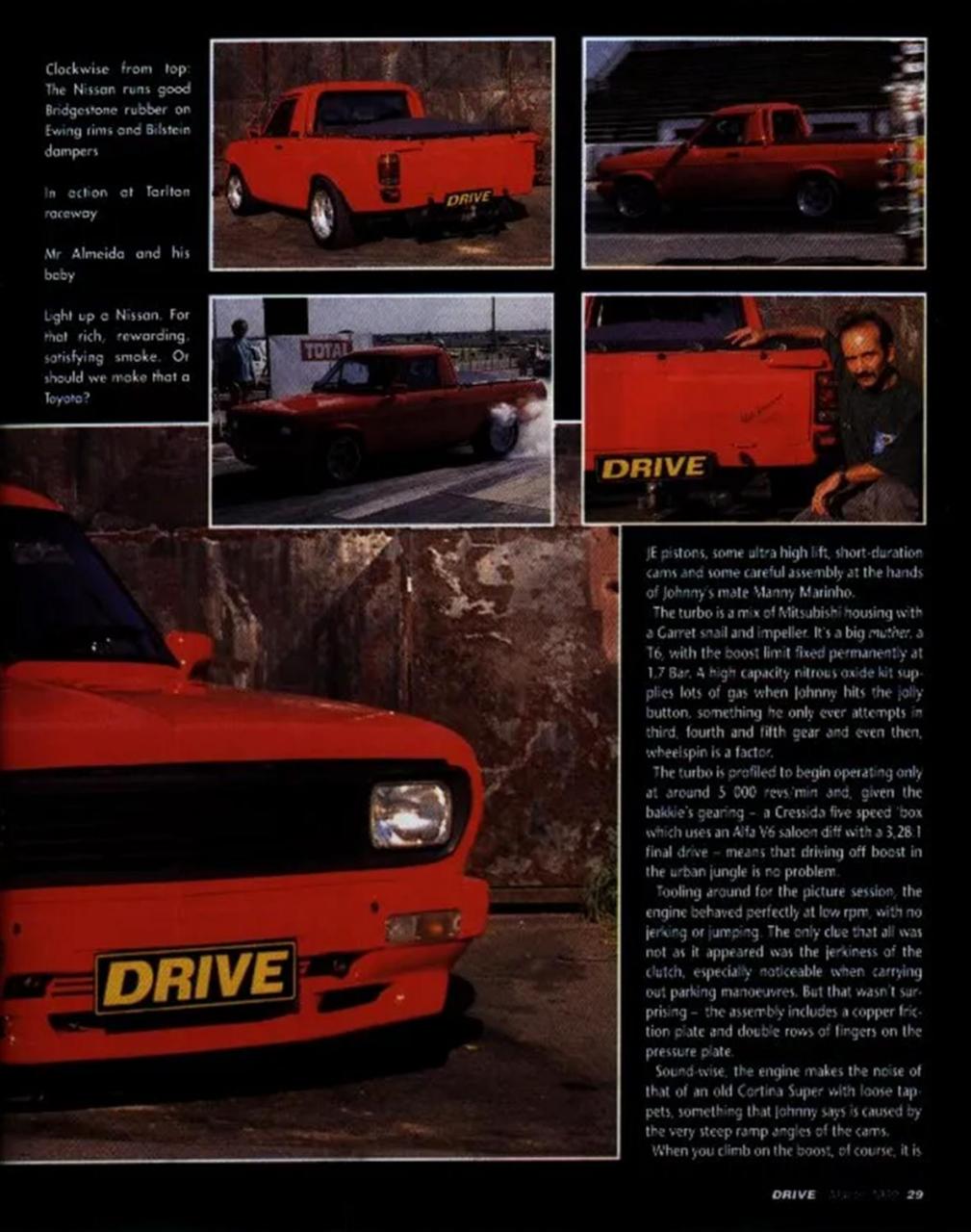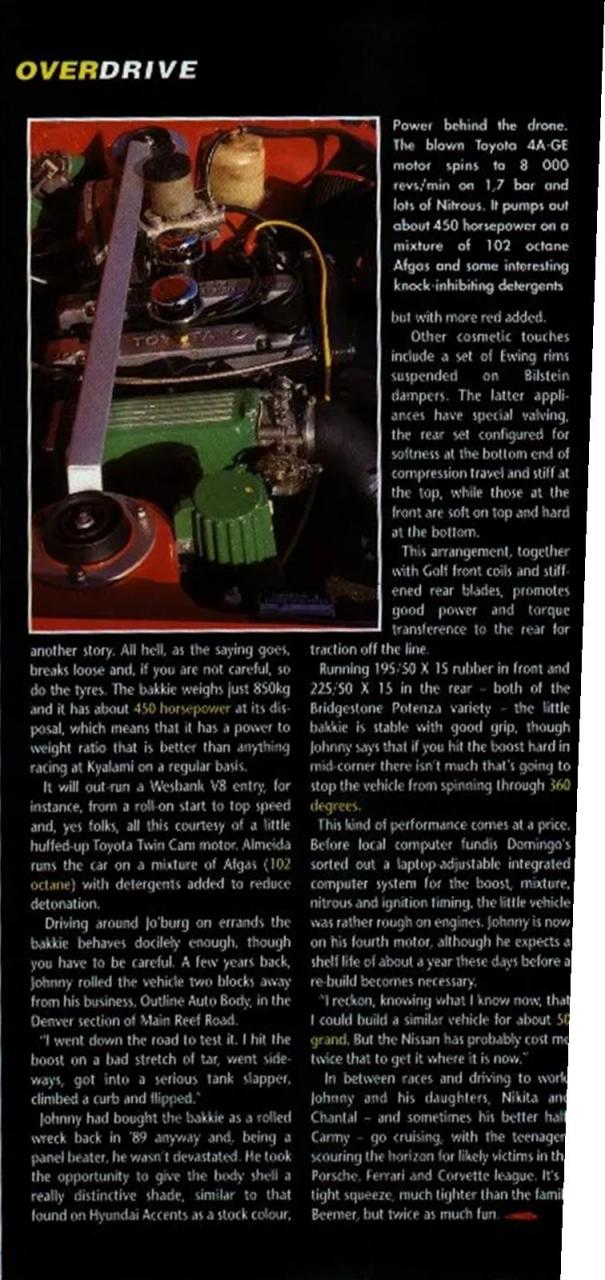<-- back to B140
"Blitzen Bakkie" from Drive magazine pages 28-30
Blitzen
Johnny Almeida's Nissan bakkie is a FERRARI-BASHER over the quarter mile and a PORSCHE-EATER on top end. And he uses it to drop off the kids at school before driving it to work every day of the week.
Stuart Johnston reports
Bakkie
On the day that Johnny Almeida broke the 300km/h barrier in his 10-year-old Nissan bakkie and thus became the owner of the fastest pick-up in South Africa, Lady Luck was working in strange ways.
"The run was on the Witbank-Pretoria highway. The organisers had closed off a section of road and set up speed traps just over a rise. I'd told the guys that I thought I could run 280km/h, but there was some confusion about where the traps were. On my first run I tapped off 100 early, recording a speed that was only in the mid 260s," says Johnny.
"I was upset. All the guys were saying: 'Hmm, what happened to that 280 you were talking about?' So on my next run I decided that no matter what happened, I was going to stay on the gas."
Just before the traps, a huge side wind gusted through the valley. It took hold of the little brick shaped pick-up and shifted it sideways across the width of two lanes.
"In normal circumstances, I would have lifted off the accelerator but, because of all the remarks flying around, I had really psyched myself up. Nothing was going to stop me, and I just drove it through, eased it back onto line and we came away with the record."
The certificate hangs on the wall of Johnny's office in Denver, the industrial sprawl east of Johannesburg. It says that he achieved a speed of 303.6km/h on March 4, 1997 — and that's just one of countless speed records that the pink-ish, tangerine-ish, immaculately-turned out 1989 Nissan has achieved.
Apart from being an extraordinary top end machine, it has also run a 12.3 second quarter mile. To give you an idea of how quick that is, standard Ferrari F355s will run the distance in the high 14 second bracket, while a perfect run from a standard 3.6-litre Porsche Turbo will yield a 13.8 or a 14-second time.
So, the big question. What makes Johnny's bakkie run? In short, a Toyota 1600 twin cammer of the famed 4A-GE configuration.
Johnny considered other engines when he began to lust for more power than the original Nissan motor could offer — after a set of side draughts and a bit of gas — and the Toyota, because of its size, was the perfect solution.
Clockwise from top: The Nissan runs good Bridgestone rubber on Ewing rims and Bilstein dampers
In action at Tarlton raceway
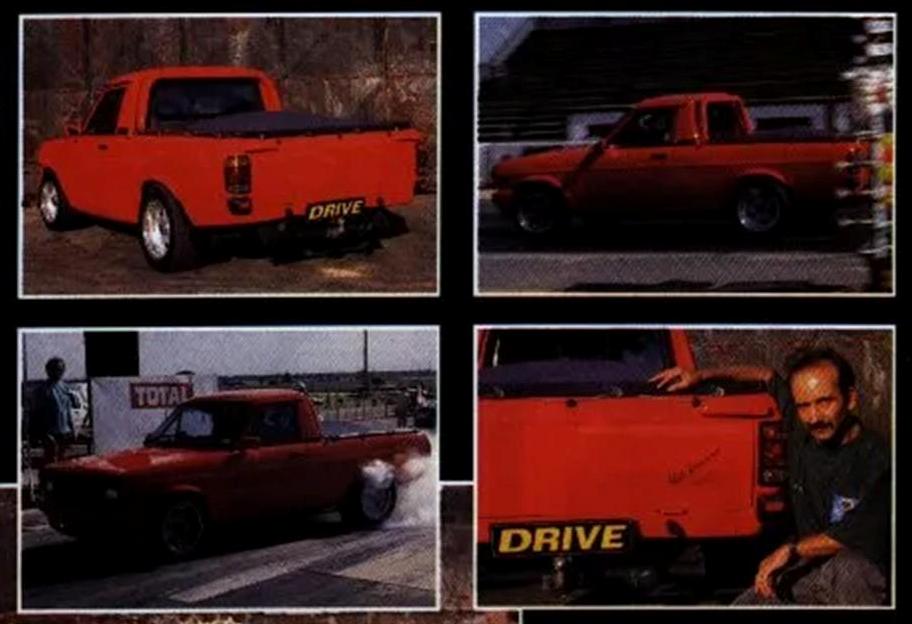
Mr Almeida and his baby
Light up a Nissan for that rich, rewarding, satisfying smoke. Or should we make that a Toyota?
For the motor features some very trick bits, including Carillo rods, forged low compression JE pistons, some ultra high lift, short-duration cams and some careful assembly at the hands of Johnny's mate Manny Marinho.
The turbo is a mix of Mitsubishi housing with a Garret snail and impeller. It's a big muther, a T6, with the boost limit fixed permanently at 1.7 Bar. A high capacity nitrous oxide kit supplies lots of gas when Johnny hits the jolly button, something he only ever attempts in third, fourth and fifth gear and even then, wheelspin is a factor.
The turbo is profiled to begin operating only at around 5 000 revs/min and, given the bakkie's gearing — a Cressida five speed box which uses an Alfa V6 saloon diff with a 3.28:1 final drive — means that driving off boost in the urban jungle is no problem.
Tooling around for the picture session, the engine behaved perfectly at low rpm, with no jerking or jumping. The only clue that all was not as it appeared was the jerkiness of the clutch, especially noticeable when carrying out parking manoeuvres. But that wasn't surprising — the assembly includes a copper friction plate and double rows of fingers on the pressure plate.
Sound-wise, the engine makes the noise of that of an old Cortina Super with loose tappets, something that Johnny says is caused by the very steep ramp angles of the cams.
Power behind the drone: The blown Toyota 4A-GE motor spins to 8 000 revs/min on 1,7 bar and lots of Nitrous. It pumps out about 450 horsepower on a mixture of 102 octane Afgas and some interesting knock-inhibiting detergents

When you climb on the boost, of course, it is
another story. All hell, as the saying goes,
breaks loose and, if you are not careful, so
do the tyres. The bakkie weighs just 850kg
and it has about 450 horsepower at its disposal, which means that it has a power to
weight ratio that is better than anything
racing at Kyalamiᴳ on a regular basis.
It will out-run a Wesbank V8ᴳ entry, for instance, from a roll-on start to top speed and, yes folks, all this courtesy of a little huffed-up Toyota Twin Cam motor. Almeida runs the car on a mixture of Avgas (102 octane) with detergents added to reduce detonation.
Driving around Jo'burg on errands the bakkie behaves docilely enough, though you have to be careful. A few years back, Johnny rolled the vehicle two blocks away from his business, Outline Auto Body, in the Denver section of Main Reef Road.
"I went down the road to test it. I hit the boost on a bad stretch of tar, went sideways, got into a serious tank slapper, climbed a curb and flipped."
Johnny had bought the bakkie as a rolled wreck back in '89 anyway and, being a panel beater, he wasn't devastated. He took the opportunity to give the body shell a really distinctive shade, similar to that found on Hyundai Accents as a stock colour, but with more red added.
Other cosmetic touches include a set of Ewing rims suspended on Bilstein dampers. The latter appliances have special valving, the rear set configured for softness at the bottom end of compression travel and stiff at the top, while those at the front are soft on top and hard at the bottom.
This arrangement, together with Golf front coils and stiffened rear blades, promotes good power and torque transference to the rear for traction off the line.
Running 195/50 X 15 rubber in front and 225/50 X 15 in the rear — both of the Bridgestone Potenza variety — the little bakkie is stable with good grip, though Johnny says that if you hit the boost hard in mid-corner there isn't much that's going to stop the vehicle from spinning through 360 degrees.
This kind of performance comes at a price. Before local computer fundis Domingo's sorted out a laptop-adjustable integrated computer system for the boost, mixture, nitrous and ignition timing, the little vehicle was rather rough on engines. Johnny is now on his fourth motor, although he expects a shelf life of about a year these days before a re-build becomes necessary,
"I reckon, knowing what I know now, that I could build a similar vehicle for about 50 grand. But the Nissan has probably cost me twice that to get it where it is now."
In between races and driving to work, Johnny and his daughters, Nikita and Chantal — and sometimes his better half Carmy — go cruising, with the teenager scouring the horizon for likely victims in the Porsche, Ferrari and Corvette league. It's a tight squeeze, much tighter than the family Beemer, but twice as much fun.
<end>

![[Datsun 1200 encyclopedia]](/wiki/upload/wiki.png)
